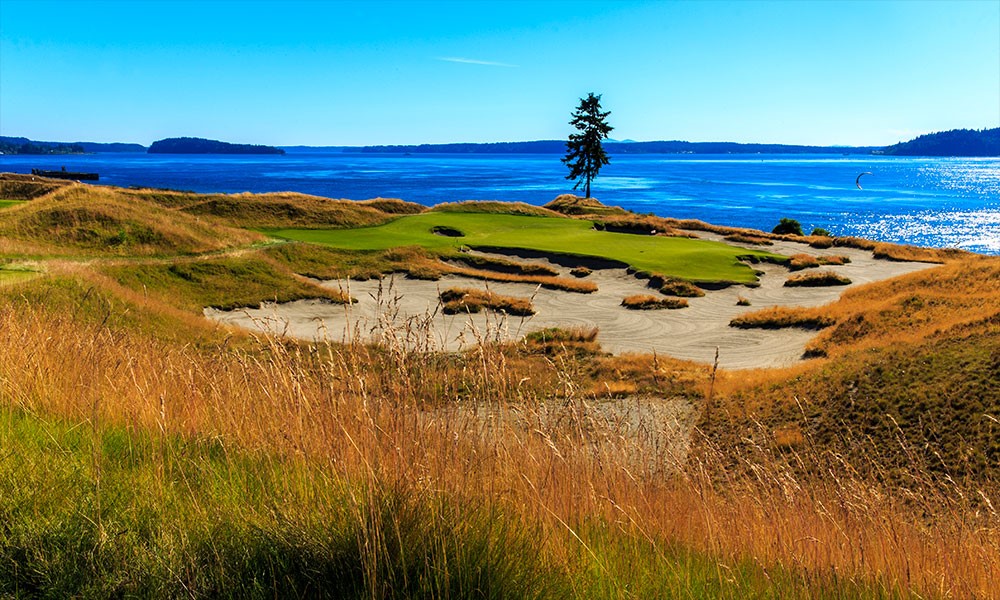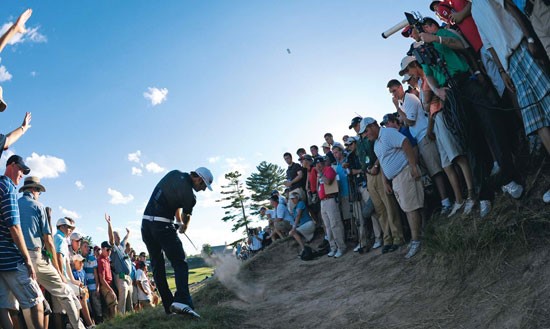Opinion & Analysis
What you can learn from the U.S. Open at Chambers Bay

Looking more like a British Open than a U.S. Open, Chambers Bay Golf Links is set to host the 115th U.S. Open. It is the first golf course in U.S. Open history to have been built specifically to host our nation’s championship.
Just minutes from Tacoma, Wash., and situated off the Puget Sound, Chambers Bay will play anywhere from 7,200–7,700 yards during this year’s championship (the maximum length of Chambers Bay is 7,940 yards). Its length won’t be the only concern for players. Navigating its treacherous terrain, fast and undulated greens, long fescue rough, and prevailing wind will make this championship one of the most difficult we have seen in recent years. Being such a difficult test, there are numerous things that you can learn from this championship that will help you in your own game.
Related: What to do near Chambers Bay
Embrace Difficult Conditions
A sure way to play poorly is by having a bad attitude or by complaining about difficult or “unfair” conditions. On the other hand, a golfer can expect to be mentally ahead of the field by embracing difficult conditions as a challenge. After all, everyone will be playing the same golf course. Interestingly enough though, not all golfers will have this attitude. There have been several articles published and videos posted of players commenting about the difficulty of Chambers Bay. While this makes for great media discussion, it doesn’t make for great golf. I don’t expect these players to hoist the trophy on Sunday afternoon. In fact, I don’t even expect them to play Chambers Bay on the weekend.
Next time you play a difficult golf course, or in the wind, or on fast greens, look at it as a challenge. Use it to your advantage. If you accept and embrace it, you will have a leg up on your opponent, and prepared to face the challenge head on.
Playing in the Wind
Pictured below, the 15th hole, a par-3 where players may play as little as a pitching wedge or as much as a fairway wood depending on the tee location and the direction of the prevailing wind, will be a pivotal hole in this year’s championship. The wind coming off of the Puget Sound will certainly be a factor this week. No. 15 is also home to the only tree on the golf course and will likely be the most televised hole of the championship.

Like the old adage goes, “When it’s breezy, swing easy,” which is a key to playing controlled shots in the wind. Club selection is an important decision to control one’s trajectory and distance. A good way to keep the ball low is to take more than enough club to reach the green and hit a knock-down shot that is flighted lower than its normal trajectory. This shot is similar to a partial wedge shot. For instance, if your sand wedge goes 100 yards for a full shot, but you only have 80 yards left to the hole, you would typically play a partial shot that flies 80 percent of the distance. Well, the same is true with longer clubs, and especially true when playing into the wind. Instead of using a 7 iron, select a 6 or even a 5 iron and swing at 80 percent. You may even experiment with moving the golf ball a fraction back in your stance to take advantage of a lower ball flight. With a little practice, this simple shot will become one of your favorites. It will flight the ball lower than normal, won’t go quite as far, and will give you far more control.
When the wind is coming from the left or right, the biggest piece of advice that I can give is to embrace the wind rather than fight it. If the wind is coming from the right, play your shot to the right of the green and allow the wind to move the ball toward the target. I see far too many golfers trying to curve the ball into the wind in an attempt to keep the ball flight straight. This is too difficult for most golfers, and will end up costing you more shots than it is worth. Remember, nature is a far more dominant force than you are. Rather than going against it, use it to your advantage.
Club Selection
Between the undulated green, the various grass lengths, the dynamic bunkers, and numerous chipping areas, Chambers Bay will provide the players with a variety of options around the greens. As a viewer, pay attention to the shot selection and club choice this week. My guess is that we will see a lot of players electing to use the putter from off the green more often than we are use to. This is primarily because the fairway length has been cut to the same length as the greens. Don’t let the links-style course fool you into believing that it is the only place where golfers should putt from off of the green. This is a great option that is far underused by the majority of club players. Putting from off of the green gets the ball rolling immediately, eliminates the big miss, and offers a lot of consistency.
Putting on Fast Greens
Speaking of putting, the U.S. Open is generally a test to see who can withstand brutal elements: thick rough and lightning fast greens. This year won’t be any different. The grainy greens of Chambers Bay are severely contoured, and will be rolling about a 12 on the Stimpmeter. The Puget Sound provides the possibility of wind playing being a factor for players try to navigate the rolling greens. Even tour players who compete at the highest level will have trouble figuring out these greens. But for us non-touring professionals, what can we do to play our best when the greens are lightning fast?
The key to putting on fast greens is adapting the stroke length so that you can make a confident stroke without the fear of blasting it past the hole. A function of developing proper speed is making a good read. Green reading plays a big role in developing the right touch on the greens. Most golfers don’t play enough break and hit the putt too hard in an attempt to keep the ball on line.
The first step to improving one’s ability to control speed is learning to play the maximum amount of break for a given putt. A drill that I like to use is one where I practice fast, breaking putts and try to trickle the ball into the hole. I usually lay an alignment stick on ground or use tees to block out the low side of the hole. If my ball hits the alignment stick or tees, I know that I missed on the low side. This drill forces me to roll the ball with enough break so that the ball enters the hole on the high side or misses high of the hole. Remember that the high side of the hole is called “The Pro Side” for a reason. As you watch this year’s U.S. Open, pay attention to the delivery speed that Tour players use on fast greens. I’ll bet that you won’t see many balls racing past the hole.
Reminder: The optimal delivery speed of a putt has it roll 6-to-8 inches past the hole when you miss.
My Pick to Win
My pick to win the 115th U.S. Open is Dustin Johnson. Having eight top-10 finishes in major championships, including a T2nd place finish at the 2011 British Open, and a win at this year’s WGC-Cadillac Championship, Johnson is no stranger to being in contention at big events. In fact, Johnson was on the wrong side of a controversial conclusion at the end of the 2010 PGA Championship at Whistling Straits. With a one-shot lead going into the 18th hole on Sunday, Johnson grounded his club in what appeared to him as a waste bunker. Upon completion of the hole Johnson was notified that the bunker was one of 1,200 hazards on the facility and would be assessed a 2-stroke penalty for grounding his club in a hazard.

Whistling Straits will again host the PGA Championship in August. While it would be storybook redemption for Dustin Johnson if he were to win his first major championship at the course where he let one slip away, my money is on him to win this week. Chambers Bay is a links style golf course similar to that of Whistling Straits, and is the perfect golf course for Dustin Johnson to break through and claim his first Major Championship. This is a demanding golf course, so don’t be surprised if the winning score is somewhere around par.
- LIKE13
- LEGIT2
- WOW2
- LOL0
- IDHT0
- FLOP0
- OB0
- SHANK2
19th Hole
Vincenzi’s 2024 Zurich Classic of New Orleans betting preview

The PGA TOUR heads to New Orleans to play the 2023 Zurich Classic of New Orleans. In a welcome change from the usual stroke play, the Zurich Classic is a team event. On Thursday and Saturday, the teams play best ball, and on Friday and Sunday the teams play alternate shot.
TPC Louisiana is a par 72 that measures 7,425 yards. The course features some short par 4s and plenty of water and bunkers, which makes for a lot of exciting risk/reward scenarios for competitors. Pete Dye designed the course in 2004 specifically for the Zurich Classic, although the event didn’t make its debut until 2007 because of Hurricane Katrina.
Coming off of the Masters and a signature event in consecutive weeks, the field this week is a step down, and understandably so. Many of the world’s top players will be using this time to rest after a busy stretch.
However, there are some interesting teams this season with some stars making surprise appearances in the team event. Some notable teams include Patrick Cantlay and Xander Schauffele, Rory McIlroy and Shane Lowry, Collin Morikawa and Kurt Kitayama, Will Zalatoris and Sahith Theegala as well as a few Canadian teams, Nick Taylor and Adam Hadwin and Taylor Pendrith and Corey Conners.
Past Winners at TPC Louisiana
- 2023: Riley/Hardy (-30)
- 2022: Cantlay/Schauffele (-29)
- 2021: Leishman/Smith (-20)
- 2019: Palmer/Rahm (-26)
- 2018: Horschel/Piercy (-22)
- 2017: Blixt/Smith (-27)
2024 Zurich Classic of New Orleans Picks
Tom Hoge/Maverick McNealy +2500 (DraftKings)
Tom Hoge is coming off of a solid T18 finish at the RBC Heritage and finished T13 at last year’s Zurich Classic alongside Harris English.
This season, Hoge is having one of his best years on Tour in terms of Strokes Gained: Approach. In his last 24 rounds, the only player to top him on the category is Scottie Scheffler. Hoge has been solid on Pete Dye designs, ranking 28th in the field over his past 36 rounds.
McNealy is also having a solid season. He’s finished T6 at the Waste Management Phoenix Open and T9 at the PLAYERS Championship. He recently started working with world renowned swing coach, Butch Harmon, and its seemingly paid dividends in 2024.
Keith Mitchell/Joel Dahmen +4000 (DraftKings)
Keith Mitchell is having a fantastic season, finishing in the top-20 of five of his past seven starts on Tour. Most recently, Mitchell finished T14 at the Valero Texas Open and gained a whopping 6.0 strokes off the tee. He finished 6th at last year’s Zurich Classic.
Joel Dahmen is having a resurgent year and has been dialed in with his irons. He also has a T11 finish at the PLAYERS Championship at TPC Sawgrass which is another Pete Dye track. With Mitchell’s length and Dahmen’s ability to put it close with his short irons, the Mitchell/Dahmen combination will be dangerous this week.
Taylor Moore/Matt NeSmith +6500 (DraftKings)
Taylor Moore has quickly developed into one of the more consistent players on Tour. He’s finished in the top-20 in three of his past four starts, including a very impressive showing at The Masters, finishing T20. He’s also finished T4 at this event in consecutive seasons alongside Matt NeSmith.
NeSmith isn’t having a great 2024, but has seemed to elevate his game in this format. He finished T26 at Pete Dye’s TPC Sawgrass, which gives the 30-year-old something to build off of. NeSmith is also a great putter on Bermudagrass, which could help elevate Moore’s ball striking prowess.
- LIKE8
- LEGIT3
- WOW1
- LOL1
- IDHT0
- FLOP3
- OB1
- SHANK2
19th Hole
Vincenzi’s 2024 LIV Adelaide betting preview: Cam Smith ready for big week down under

After having four of the top twelve players on the leaderboard at The Masters, LIV Golf is set for their fifth event of the season: LIV Adelaide.
For both LIV fans and golf fans in Australia, LIV Adelaide is one of the most anticipated events of the year. With 35,000 people expected to attend each day of the tournament, the Grange Golf Club will be crawling with fans who are passionate about the sport of golf. The 12th hole, better known as “the watering hole”, is sure to have the rowdiest of the fans cheering after a long day of drinking some Leishman Lager.
The Grange Golf Club is a par-72 that measures 6,946 yards. The course features minimal resistance, as golfers went extremely low last season. In 2023, Talor Gooch shot consecutive rounds of 62 on Thursday and Friday, giving himself a gigantic cushion heading into championship Sunday. Things got tight for a while, but in the end, the Oklahoma State product was able to hold off The Crushers’ Anirban Lahiri for a three-shot victory.
The Four Aces won the team competition with the Range Goats finishing second.
*All Images Courtesy of LIV Golf*
Past Winners at LIV Adelaide
- 2023: Talor Gooch (-19)
Stat Leaders Through LIV Miami
Green in Regulation
- Richard Bland
- Jon Rahm
- Paul Casey
Fairways Hit
- Abraham Ancer
- Graeme McDowell
- Henrik Stenson
Driving Distance
- Bryson DeChambeau
- Joaquin Niemann
- Dean Burmester
Putting
- Cameron Smith
- Louis Oosthuizen
- Matt Jones
2024 LIV Adelaide Picks
Cameron Smith +1400 (DraftKings)
When I pulled up the odds for LIV Adelaide, I was more than a little surprised to see multiple golfers listed ahead of Cameron Smith on the betting board. A few starts ago, Cam finished runner-up at LIV Hong Kong, which is a golf course that absolutely suits his eye. Augusta National in another course that Smith could roll out of bed and finish in the top-ten at, and he did so two weeks ago at The Masters, finishing T6.
At Augusta, he gained strokes on the field on approach, off the tee (slightly), and of course, around the green and putting. Smith able to get in the mix at a major championship despite coming into the week feeling under the weather tells me that his game is once again rounding into form.
The Grange Golf Club is another course that undoubtedly suits the Australian. Smith is obviously incredibly comfortable playing in front of the Aussie faithful and has won three Australian PGA Championship’s. The course is very short and will allow Smith to play conservative off the tee, mitigating his most glaring weakness. With birdies available all over the golf course, there’s a chance the event turns into a putting contest, and there’s no one on the planet I’d rather have in one of those than Cam Smith.

Louis Oosthuizen +2200 (DraftKings)
Louis Oosthuizen has simply been one of the best players on LIV in the 2024 seas0n. The South African has finished in the top-10 on the LIV leaderboard in three of his five starts, with his best coming in Jeddah, where he finished T2. Perhaps more impressively, Oosthuizen finished T7 at LIV Miami, which took place at Doral’s “Blue Monster”, an absolutely massive golf course. Given that Louis is on the shorter side in terms of distance off the tee, his ability to play well in Miami shows how dialed he is with the irons this season.
In addition to the LIV finishes, Oosthuizen won back-to-back starts on the DP World Tour in December at the Alfred Dunhill Championship and the Mauritus Open. He also finished runner-up at the end of February in the International Series Oman. The 41-year-old has been one of the most consistent performers of 2024, regardless of tour.
For the season, Louis ranks 4th on LIV in birdies made, T9 in fairways hit and first in putting. He ranks 32nd in driving distance, but that won’t be an issue at this short course. Last season, he finished T11 at the event, but was in decent position going into the final round but fell back after shooting 70 while the rest of the field went low. This season, Oosthuizen comes into the event in peak form, and the course should be a perfect fit for his smooth swing and hot putter this week.

- LIKE12
- LEGIT3
- WOW1
- LOL1
- IDHT0
- FLOP1
- OB1
- SHANK1
Opinion & Analysis
The Wedge Guy: What really makes a wedge work? Part 1

Of all the clubs in our bags, wedges are almost always the simplest in construction and, therefore, the easiest to analyze what might make one work differently from another if you know what to look for.
Wedges are a lot less mysterious than drivers, of course, as the major brands are working with a lot of “pixie dust” inside these modern marvels. That’s carrying over more to irons now, with so many new models featuring internal multi-material technologies, and almost all of them having a “badge” or insert in the back to allow more complex graphics while hiding the actual distribution of mass.
But when it comes to wedges, most on the market today are still single pieces of molded steel, either cast or forged into that shape. So, if you look closely at where the mass is distributed, it’s pretty clear how that wedge is going to perform.
To start, because of their wider soles, the majority of the mass of almost any wedge is along the bottom third of the clubhead. So, the best wedge shots are always those hit between the 2nd and 5th grooves so that more mass is directly behind that impact. Elite tour professionals practice incessantly to learn to do that consistently, wearing out a spot about the size of a penny right there. If impact moves higher than that, the face is dramatically thinner, so smash factor is compromised significantly, which reduces the overall distance the ball will fly.
Every one of us, tour players included, knows that maddening shot that we feel a bit high on the face and it doesn’t go anywhere, it’s not your fault.
If your wedges show a wear pattern the size of a silver dollar, and centered above the 3rd or 4th groove, you are not getting anywhere near the same performance from shot to shot. Robot testing proves impact even two to three grooves higher in the face can cause distance loss of up to 35 to 55 feet with modern ‘tour design’ wedges.
In addition, as impact moves above the center of mass, the golf club principle of gear effect causes the ball to fly higher with less spin. Think of modern drivers for a minute. The “holy grail” of driving is high launch and low spin, and the driver engineers are pulling out all stops to get the mass as low in the clubhead as possible to optimize this combination.
Where is all the mass in your wedges? Low. So, disregarding the higher lofts, wedges “want” to launch the ball high with low spin – exactly the opposite of what good wedge play requires penetrating ball flight with high spin.
While almost all major brand wedges have begun putting a tiny bit more thickness in the top portion of the clubhead, conventional and modern ‘tour design’ wedges perform pretty much like they always have. Elite players learn to hit those crisp, spinny penetrating wedge shots by spending lots of practice time learning to consistently make contact low in the face.
So, what about grooves and face texture?
Grooves on any club can only do so much, and no one has any material advantage here. The USGA tightly defines what we manufacturers can do with grooves and face texture, and modern manufacturing techniques allow all of us to push those limits ever closer. And we all do. End of story.
Then there’s the topic of bounce and grinds, the most complex and confusing part of the wedge formula. Many top brands offer a complex array of sole configurations, all of them admittedly specialized to a particular kind of lie or turf conditions, and/or a particular divot pattern.
But if you don’t play the same turf all the time, and make the same size divot on every swing, how would you ever figure this out?
The only way is to take any wedge you are considering and play it a few rounds, hitting all the shots you face and observing the results. There’s simply no other way.
So, hopefully this will inspire a lively conversation in our comments section, and I’ll chime in to answer any questions you might have.
And next week, I’ll dive into the rest of the wedge formula. Yes, shafts, grips and specifications are essential, too.
- LIKE34
- LEGIT7
- WOW1
- LOL1
- IDHT2
- FLOP3
- OB1
- SHANK3
-

 19th Hole2 weeks ago
19th Hole2 weeks agoDave Portnoy places monstrous outright bet for the 2024 Masters
-

 19th Hole4 days ago
19th Hole4 days agoJustin Thomas on the equipment choice of Scottie Scheffler that he thinks is ‘weird’
-

 19th Hole2 weeks ago
19th Hole2 weeks agoTiger Woods arrives at 2024 Masters equipped with a putter that may surprise you
-

 19th Hole4 days ago
19th Hole4 days ago‘Absolutely crazy’ – Major champ lays into Patrick Cantlay over his decision on final hole of RBC Heritage
-

 19th Hole2 weeks ago
19th Hole2 weeks agoTwo star names reportedly blanked Jon Rahm all week at the Masters
-

 19th Hole1 week ago
19th Hole1 week agoReport: LIV Golf identifies latest star name they hope to sign to breakaway tour
-

 19th Hole2 weeks ago
19th Hole2 weeks agoNeal Shipley presser ends in awkward fashion after reporter claims Tiger handed him note on 8th fairway
-

 19th Hole1 week ago
19th Hole1 week agoBrandel Chamblee has ‘no doubt’ who started the McIlroy/LIV rumor and why

















Twaddle
Jun 20, 2015 at 3:28 am
DJ could win it, for sure. I think the set up suits him well, and as long as some putts fall, he can do it. The course is giving up birdies, there are a decent amount of sub-par scores, so I don’t know what all the fuss is about with the guys complaining about the course. There have been green and lush courses with much harsher, thicker, juicier rough than this that have ended up with only a couple players at par or better, so what’s the fuss?
Pat M
Jun 20, 2015 at 10:58 pm
I turned it off. The greens in the photo look great. In real life and on TV they are awful. I cannot see the ball on high definition big screen TV in HD. it gave me a headache and the clown show course is tedious. Mike Davis should be fired. The players are great. The PGA and USGA are awful. Awful course.
Henry Stetina
Jun 18, 2015 at 4:10 pm
Interesting! Matsuyama is my #3 pick. He has been really tough lately.
Christosterone
Jun 18, 2015 at 3:37 pm
Matsuyama beats Stenson in a playoff…book it
Henry Stetina
Jun 18, 2015 at 4:10 pm
Interesting! Matsuyama is my #3 pick. He has been really tough lately.